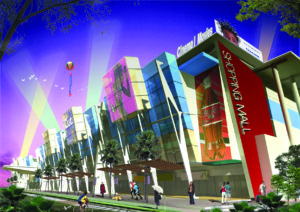An Interview with An Industry Expert
In 2015, the shopping centre industry was faced with a new challenge, namely the introduction of a new tax system in Malaysia. According to Tan Hai Hsin, Managing Director of Henry Butcher Retail, consumers’ spending was affected from second quarter of 2015 due to the implementation of the Goods & Services Tax (GST) on 1 April 2015. But that is not the only negative impact that the retail industry faces. With an expected 17 million sq ft of shopping space coming into the Klang Valley from now until 2019, as reported in The Star, industry experts are concerned that this will result in an oversupply situation. Following is an interview with Tan Hai Hsin.
With the number of new shopping malls sprouting up all over the country, especially in the Klang Valley, do you see these malls sustaining themselves in the long run?
In Malaysia, there are 899 shopping centres with a total nett floor area of 137 million sf. The average occupancy rate is 81.3%. Modern, air-conditioned purpose-built shopping centre that offers one-stop shopping for goods and services is a real estate development trend not only in Malaysia, but also around the world. Serious oversupply of retail space is not apparent in secondary cities in Malaysia. There are still abandoned shopping centres found in Penang and Johor. They were left behind since the last Asian financial crisis in 1998.
The critical success factors of shopping centres in Malaysia are:
- All retail shops are owned by a single landlord, not large number of individual owners
- It is managed by a team of professionals
- Pro-active management team. They are responsive to changes in retail markets and consumers’ shopping behaviour and patterns
The Knight Frank Malaysia Real Estate Highlights 1H2015 stated that the Klang Valley retail market will face further dilution with the scheduled completion of 13 new shopping malls by 2H2015/early 2016. Do you agree with this outlook?
Yes, I agree in general. But ‘dilution’ may not be the right word. The retail market does not just spread evenly to all the shopping centres and all will be affected as a result. The successful ones are mostly likely to remain popular with queue of retailers wanting to join. Shoppers will continue to visit these popular shopping centres due to their wide ranges of offerings. The already poorly occupied shopping centres will remain so with great challenges ahead to lift the occupancy rates.
The old shopping centres will face pressure from the new ones. They need to refurbish in order to meet today’s shoppers’ needs. If they do not do so, they will lose tenants moving to new shopping centres.
The new shopping centres will face financial challenge in order to attract new tenants. To attract tenants, they need to lower their rental rates in order to lure them. Strata-titled shopping centres will face challenges to re-invest themselves in order to meet the market changes due to multiple ownerships. A recent example is Plaza Sungei Wang.
In 2012, it was reported that there were discussions that also involved PPK, to put forward a proposal to the government to impose a moratorium on the construction of new shopping centres. Do you think a moratorium is needed right now? If yes, how long should the moratorium be? Should it be confined to certain areas?
I disagree on government intervention in retail property market. A freeze in shopping centre development does not resolve the oversupply situation. Let market forces adjust the demand and supply of shopping centres in Malaysia.
Existing failures and low investment returns will deter developers and retail investors from entering the market. The difficulty to obtain loans will also stop developers with limited financial resources to proceed with the projects. Empty shops with no rentals for months or even years will prevent retail investors to put money into strata-titled shopping centre developments.
With more and more consumers shopping online and major brands venturing into e-commerce, is this a threat to physical shopping malls? It was reported last year that Singapore is “over retail”, with too many malls and too few shoppers. Is Malaysia heading in that direction, or are we already there?
Online shopping (Malaysia and overseas) is a threat to brick-and-mortar shops. But it will not lead to the disappearance of physical shops.
More and more brick-and-mortar retailers in Malaysia now offer online shopping facility. This trend covers almost all retail sectors – international luxury brands, fashion clothes, fashion accessories, gifts, toys, books, electrical & electronics, furniture, hardware, buildware, grocery, foods and beverages, etc.
At the same time, more online retailers in Malaysia are setting up physical stores. Zalora.com.my has a permanent premise at Mitsui Outlet Park. The well-known Christy Ng Shoes has set up her showroom in Damansara Utama. Popular Facebook Fatbaby ice cream has set up an ice cream parlour in Subang Jaya.
How do you see the growth of the retail industry in 2016?
Based on current market conditions and the latest Budget 2016, retail market is not expected to improve significantly in the first half of 2016.
GST has affected all retail sub-sectors (from retailers selling grocery, fashion and fashion accessories, electrical & electronics, foods and beverages and overseas travel) since 1 April 2015. Businesses of many retailers dropped from 20% to 50%. Consumers’ spending has yet to recover to pre-GST level.
The current political development in our country is affecting retail sales indirectly. The current political situation is affecting the consumer sentiment level or buying mood of Malaysian consumers. They are frustrated, they are confused and they are uncertain of their future in this country. As a result, they are less willing to buy more.
The weak Ringgit is affecting costs of goods due to higher import costs. This will lead to higher retail prices. Higher import costs are affecting all retail sectors, from grocery stores, restaurants, fashion stores, furniture stores, electrical & electronics stores, etc. Higher retail prices are now more apparent since the beginning of fourth quarter of this year. We expect Malaysian consumers’ purchasing power will decline further. The recent toll hikes will lead to another round of price increases in the next few months.
The recent Budget 2016 did not introduce measures and incentives that can spur consumers’ spending in the first half of 2016.
(For detailed information on the retail industry of Malaysia, please refer to next page)







